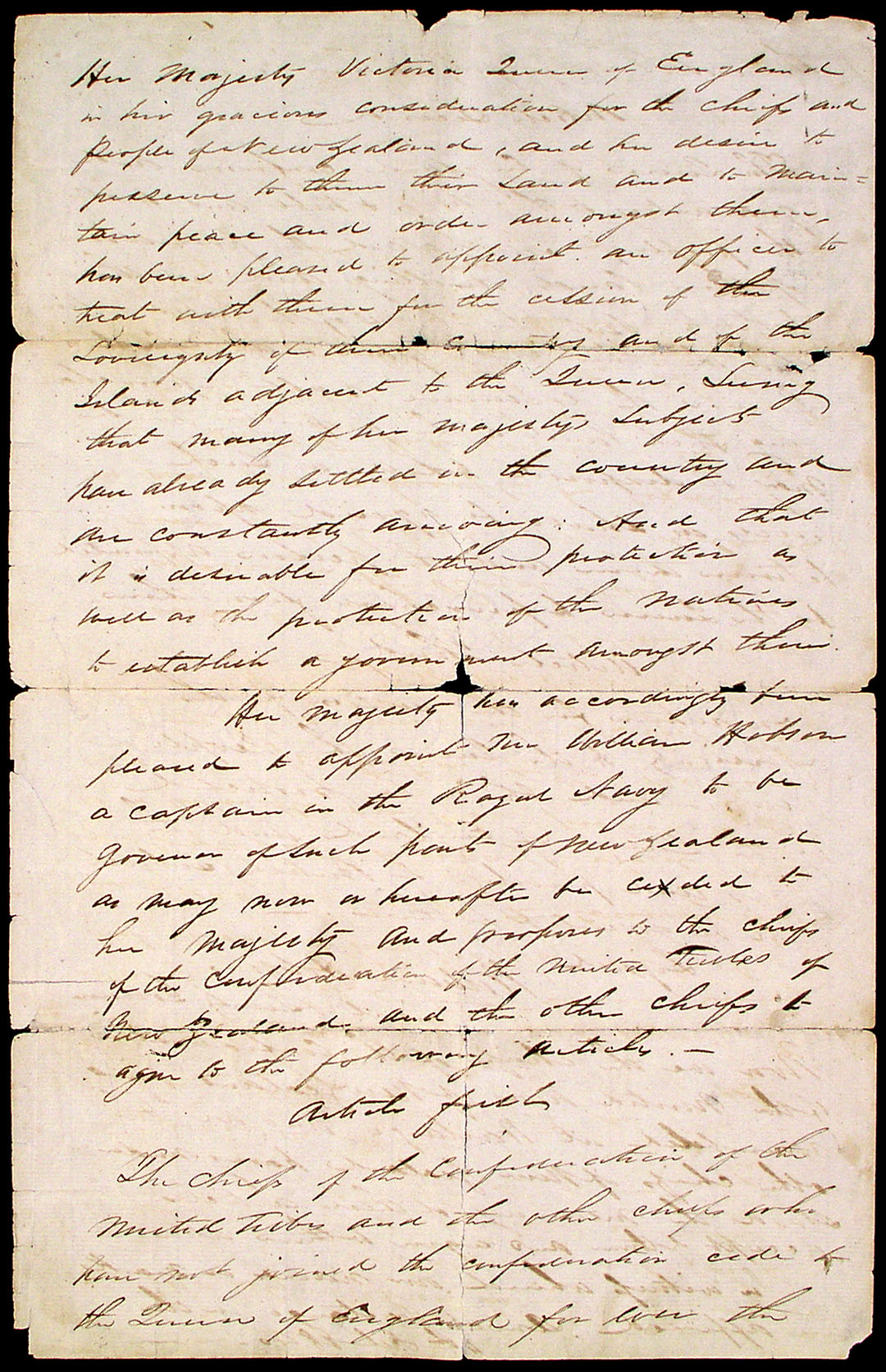The Littlewood Treaty, The True English Text of the Treaty of Waitangi, Found
Chapter: Précis 1 2 3 4 5a, 5b, 5c, 5d, 5e 6 7 8 9 10 11 12 13 14 15 16 17 18 19 20 Lord Normanby's Brief Additional Resources
Chapter 5E
THE ROUGH NOTES ARE, SIMPLY ROUGH NOTES. THERE’S NO FINAL DRAFT HERE!
It must be admitted that there is no clear-cut or complete final draft amongst the 16-pages of surviving draft notes from which the Tiriti O Waitangi could be translated.
These rough working notes and developments are too raw, with too many confusing additions or deletions for Reverend Henry Williams to work from in creating the Maori Tiriti O Waitangi.
Hobson and his advisors had an absolute duty to provide the translators with a complete, clearly set out and concise final draft, containing no ambiguity or confusion within the text that could lead to mistakes being made. The role of Reverend Henry Williams was to act as TRANSLATOR. His sole duty was to convey, as closely as possible, the ideas, statements and intents of the LEGISLATORS.
The treaty itself was based upon stringent guidelines provided by Lord Normanby of the Colonial Office, who furnished Hobson with a 4200 word brief before Hobson left England. This brief stipulated that certain basic requirements must be met and adhered to if Britain were to set up a colony in New Zealand. If these requirements could not be secured by treaty, then Britain would not entertain any plans of colonisation.
Following Hobson’s arrival in Australia, he underwent further briefings in consultation with Governor of New South Wales, Sir George Gipps.
Hobson certainly understood the concept of “duty to Queen and Country” and his exploits of fighting pirates in the West Indies had provided the inspiration for a popular book featuring the fictional, seafaring, folk hero of the times, Tom Cringle.
This commission by Hobson to secure a treaty and, eventually,
become Governor of New Zealand was to be the crowning glory that followed
a long and distinguished naval career. Hobson had visited New Zealand in
1837 as captain of H.M.S. Rattlesnake and it was largely due to the recommendations
contained in his report that enticed the British Parliament to allow a colony
to be formed in the, geographically, most distant, habitable country from
the seat of British government.
To suggest that Hobson might have arrived in the country with a lacsadasical
or mediocre attitude towards his assignment in behalf of Queen Victoria
belies his nature. If anything, Hobson was an overachiever, who always pushed
himself very hard, often to the detriment of his health and well-being.
Upon arrival in New Zealand on the 29th of January 1840 he set himself the ominous task of both writing a treaty and meeting with the chiefs within the short space of one week, to present the Queen’s proposal to them. This was the most important document Hobson would ever write, as it was to be the foundation compact or contract upon which a colony of Britain would be built. It had to encompass all of the themes and recommendations contained within Normanby’s 4200-word brief, as well as those conveyed in direct consultation with several other British authorities in England and Australia.
By scrutinising the rough notes, we are able to clearly see the difficulties that Hobson and his helpers encountered in devising, then assembling a final treaty text. Many ideas were proposed and discarded and the 16-pages of developing rough notes contain little more than a shadow of the final, concentrated wording that was, ultimately, decided upon.
No translator would be capable of creating the Maori Tiriti O Waitangi from those rough notes alone, as nothing is finished to a sufficiently clear standard, wherein it is obvious what is to be included and what is to be rejected. Hobson owed Reverend Williams nothing less than a completed “final draft”.
The Littlewood Treaty draft is the natural extension to these surviving 16-pages and qualifies as the only known final English draft, complete in all sections.
The last 8 pages of the rough notes were written, by Busby, between the 2nd and 3rd of February 1840. The Littlewood Treaty is dated the 4th of February 1840 and has been identified by Dr. Phil Parkinson to be in the handwriting of James Busby. Its wording constitutes the final refinement, after considering many ideas, and the resultant text perfectly mirrors, sentence by sentence, the Maori wording.
Let’s now add Busby’s 4th of February final draft (the Littlewood Treaty) and see Hobson’s finished, corrected and concise text, refined in all sections and ready to hand to the translators.


The Littlewood Treaty document (Busby's final English draft to the Treaty of Waitangi), which mirrors the text found on the Maori Tiriti O Waitangi perfectly, sentence by sentence. It can be seen from the 16-draft pages that preceded this final draft that nothing is sufficiently complete or organised enough within those rough notes (written between the 31st of January and 3rd of February 1840) to hand to the translators. The Littlewood Treaty (written on the 4th of February) is the only document in the developing series that contains the completed features of Preamble, Articles I, II, III & Affirmation section.